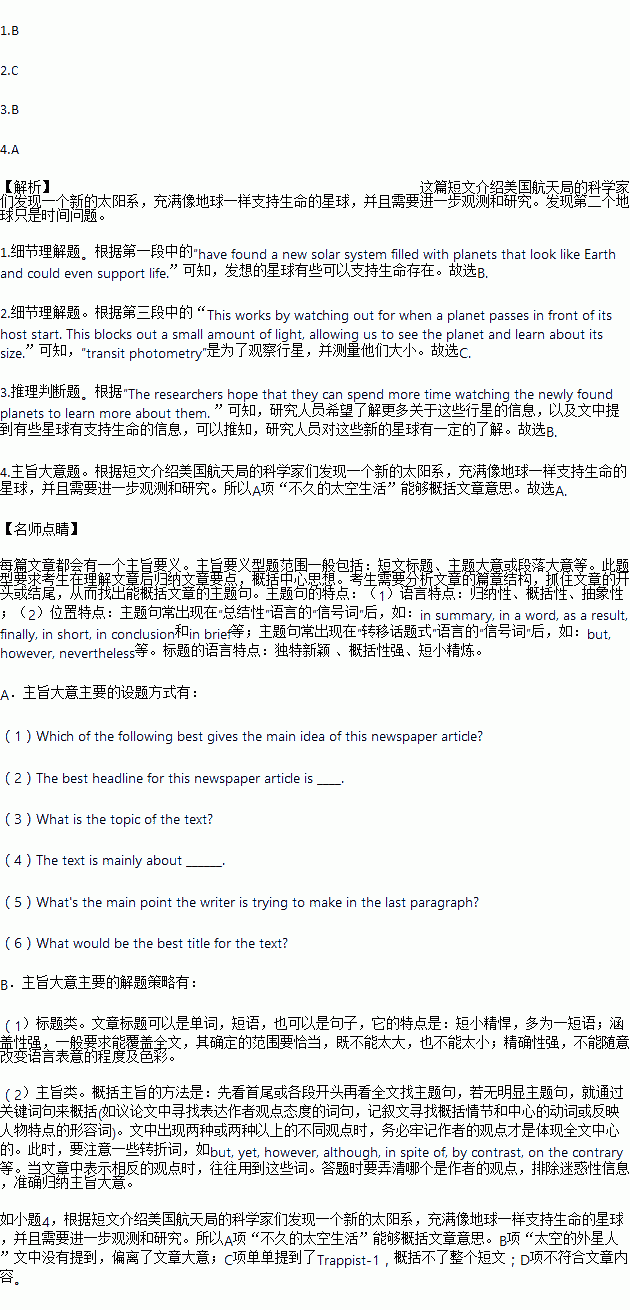题目内容
It seems that we are one step closer to finding alien life and maybe a future home for humanity. Scientists from NASA (National Aeronautics and Space Administration) have found a new solar system filled with planets that look like Earth and could even support life.
The group of seven planets, which orbits a star called Trappist-1, is 40 light years away from Earth in the constellation of Aquarius(水瓶座). And three of them are in the so-called “habitable (宜居的)zone” ----the area around a star where liquid water is most likely to be found. This is important because water is a necessary ingredient for life.
All of the planets were found using a method called “transit photometry.” This works by watching out for when a planet passes in front of its host start. This blocks out a small amount of light, allowing us to see the planet and learn about its size.
“This is an amazing planetary system---not only because we have found so many planets, but because they are all surprisingly similar in size to the Earth,” astronomer Michael Gillon from the University of Liege in Belgium told The Independent.
Trappist-1 is a “dwarf star (矮星)” which is colder and shines dimmer than our sun. If a person were on one of the seven planets, everything would look a lot darker than usual. The amount of light heading toward our eyes would be about 200 times less than we get from the sun, according to The Independent.
Because of that, Trappist-1, together with many other dwarf stars, was never on the list of places where scientists look for alien life. but Michael Gillon, lead researcher behind the discovery, decided to give dwarf stars a chance. He built a telescope in Chile to observe 60 of the closest dwarf stars, and it turned out that Trappist-1 was worthy of the effort.
The researchers hope that they can spend more time watching the newly found planets to learn more about them. Even though more research is needed before determining whether these planets could really support life, the discovery is still encouraging. It shows just how many Earth-size planets could be out there.
“The discovery gives us a hint that finding a second Earth is not just a matter of if, but when,” NASA scientist Thomas Zurbuchen told the Telegraph.
1.Which of the following statements is TRUE about the newly found planets?
A. It will take human beings about 40 years to travel to them
B. Some of them might have the proper conditions to support life
C. They are spread out in the habitable zone around Trappist-1
D. Underground ice has been found in some them
2.“Transit photometry” is a special method mainly used to ________.
A. tell apart different stars
B. test the brightness of stars
C. search for and measure planets
D. work out the distance between stars
3.We can infer from the article that _______.
A. scientists will soon find an Earth-like planet that can support human life
B. researchers know a little about the environment on the newly found planets
C. dwarf stars have long been a popular choice in the hunt for Earth-like planets
D. the size of a planet is the top concern when scientists search for a “second Earth”
4.Which of the following can be the best title of the passage?
A. Life in space soon?
B. Any aliens in space?
C. Trappist-1, a dark dwarf star
D. New record, seven new solar systems

